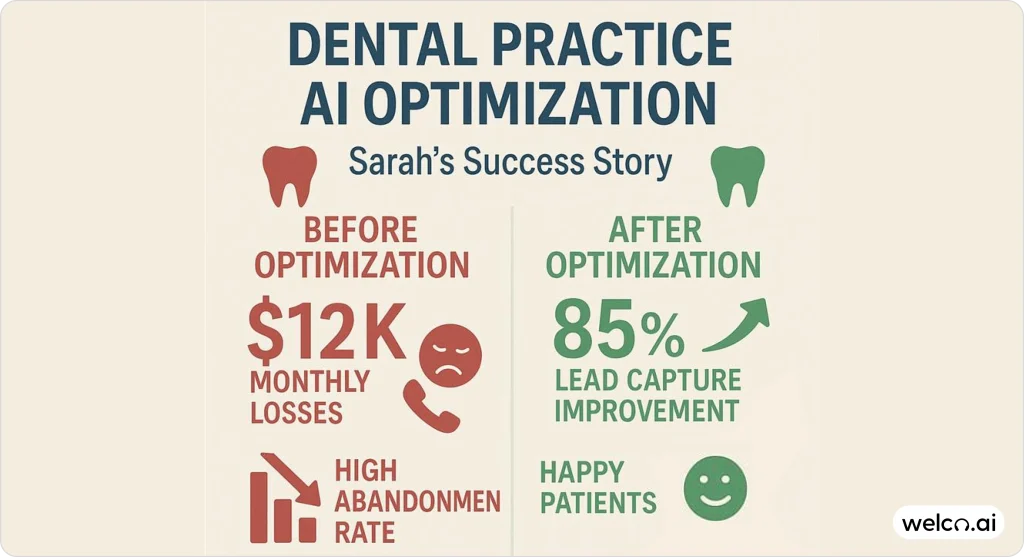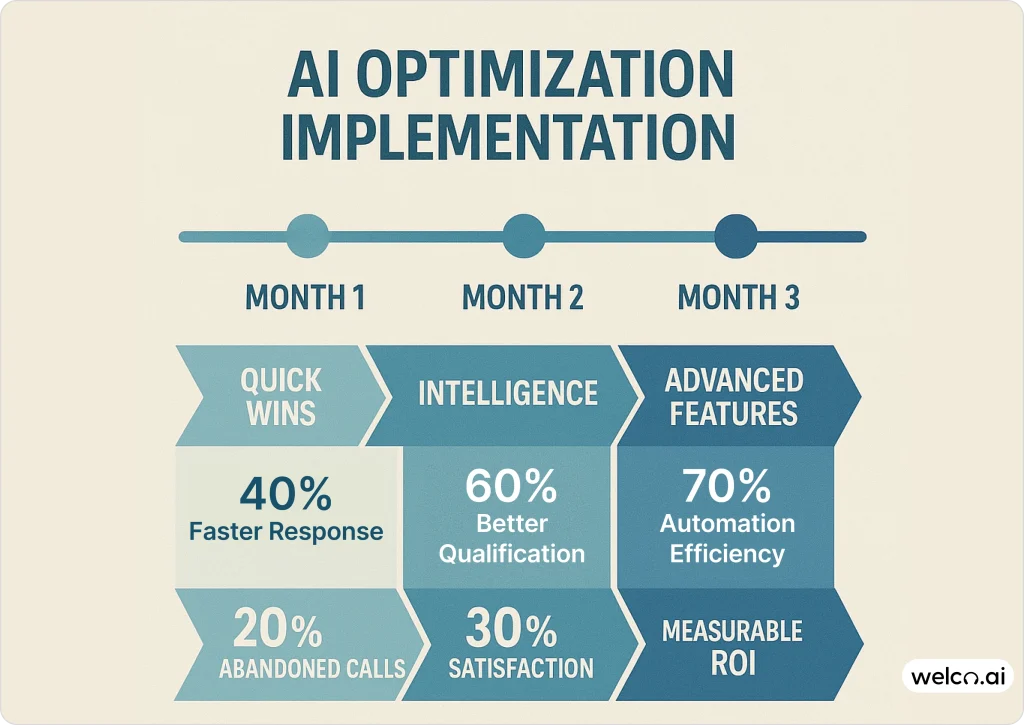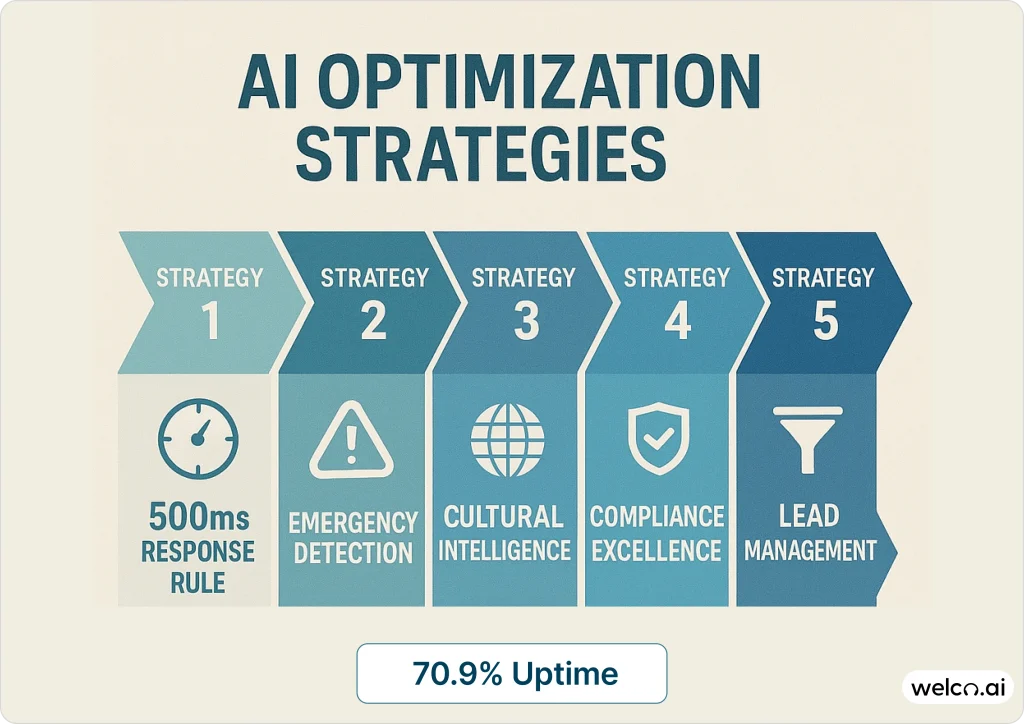The $12,000 Monthly Problem Hiding in Plain Sight
Last month, a business owner watched $8,000 in emergency service calls go straight to his competitor. His AI phone system was “working perfectly”—it just couldn’t recognize that frantic homeowners needed immediate customer support, not a patient questionnaire.
The difference? Strategic optimization.
After working with dozens of businesses to optimize their AI reception systems, I’ve discovered that most organizations are hemorrhaging revenue not because they lack AI technology, but because they’re using it like an expensive answering machine instead of a strategic business tool.
Consider Dr. Martinez, whose dental practice seemed to have everything under control. His AI answering service answered every call professionally, scheduled appointments efficiently, and never missed a beat. But when we analyzed his 24/7 customer service system, the truth was devastating: frustrated callers were hanging up during interactions at an alarming rate, costing his practice approximately $12,000 monthly in lost appointments.
The problem wasn’t the technology—it was the complete lack of optimization for real-world customer behavior.
After systematic service optimization, Dr. Martinez’s practice improved lead capture by 85% and transformed customer satisfaction scores. More importantly, those monthly losses turned into monthly gains as the AI receptionist began recognizing and responding to actual human needs rather than just processing information. This foundation of optimization builds upon understanding the psychology of first impressions, where businesses lose customers in the critical first 100 milliseconds of contact.

Strategy #1: The 500-Millisecond Response Rule (Start Here)
Best for: Beginners | Timeline: 3-4 weeks
Here’s what most business owners don’t realize: during busy periods, basic AI phone systems respond in 1,000-1,500 milliseconds—enough time for customers to think “robot” and start planning their escape. Your brain processes “professional” versus “cheap automation” faster than you can consciously recognize it.
Optimized systems target sub-500ms responses, creating the psychological impression of immediate, attentive service.
Technical Foundation (Weeks 1-2)
- Audit current response times using system analytics
- Upgrade voice processing to reduce computational delays
- Implement response caching for frequently asked questions
Quality Enhancement (Weeks 3-4)
- Test AI voice options with real customer feedback
- Add natural pauses (150-200ms) that mimic human thinking patterns
- Map conversation flows for your most common call types
Real Results: TechFlow HVAC reduced response times from 1,200ms to 350ms, resulting in 30% fewer abandoned calls and $47,000 additional revenue over six months. Their secret? Customers stopped perceiving the interaction as “robotic” and started engaging naturally. For businesses looking to enhance these interactions further, implementing personalization in automated customer interactions can significantly amplify response time improvements.
Strategy #2: Emergency Detection That Saves High-Value Calls
Complexity: Intermediate | Implementation: 5-6 weeks
Basic AI receptionists treat a burst pipe on Christmas morning the same as a routine appointment request. When customers are panicked about emergencies, they need immediate escalation—not standard protocols that make them feel unheard and desperate.
Detection Framework
Layer 1: Keyword Recognition
- Universal terms: “emergency,” “urgent,” “broken”
- Industry-specific: “chest pain” (healthcare), “no heat” (HVAC), “water damage” (restoration)
Layer 2: Voice Pattern Analysis
- Rapid speech patterns indicating panic
- Elevated voice pitch suggesting stress
- Repetitive language showing frustration
Layer 3: Context Scoring
- Emergency keywords (+5 points)
- After-hours timing (+3 points)
- VIP customer status (+3 points)
- Score threshold of 8+ triggers immediate human escalation
Game-Changing Results: Emergency Plumbing Solutions implemented this emergency call detection system and stopped losing high-value emergency calls to competitors. They now achieve sub-15-minute response times for critical issues with nearly 100% successful emergency escalation rates. Weekend revenue increased 180% as panicked homeowners finally found a business that understood their urgency. However, even the best emergency detection fails if the underlying call routing psychology doesn’t account for how stressed customers actually behave during crisis situations.
Strategy #3: Cultural Intelligence That Actually Works
Requirements: Moderate setup | Timeframe: 6-8 weeks
Your AI receptionist greeting a Japanese customer with casual American slang feels unprofessional and disrespectful—like wearing flip-flops to a business meeting. Different cultures have completely different expectations for professional communication.
Take Miami Legal Services, which serves a heavily international clientele. Their generic AI greeting was accidentally offending potential clients from formal business cultures while seeming too stiff for Latin American customers who expected warmer, family-oriented communication.
Before optimization: “Hello, this is Miami Legal Services. How can I help you?”
After cultural adaptation: “Good morning, and thank you for contacting Miami Legal Services. It would be my honor to assist you today.” (for formal cultures) or “¡Buenos días! Thank you for calling our family practice. How can we help your family today?” (for Latin American clients)
The results? 60% improvement in satisfaction from international clients and measurable revenue increases from global market expansion.
Implementation Process
- Identify your top customer regions based on call volume
- Research cultural communication preferences for each region
- Adjust AI voice characteristics and conversation pacing accordingly
- Test with native speakers before full deployment
Companies implementing cultural intelligence typically report 50%+ higher satisfaction from international customers and measurable revenue increases from global market expansion. Organizations serving diverse customer bases can further amplify these results by implementing comprehensive multilingual AI capabilities that go beyond basic cultural adaptation to full language support.
SStrategy #4: Industry-Specific Compliance Excellence
Complexity: Advanced | Investment: 8-12 weeks
Regulated industries face a brutal reality: generic AI systems often create compliance violations that cost more than the technology saves. But proper compliance becomes your competitive moat—most competitors can’t or won’t invest in getting it right.
Healthcare (HIPAA Compliance)
- End-to-end encryption with proper business associate agreements
- Automatic PHI detection and role-based access controls
- Audit trail maintenance for compliance documentation
Results: Westside Family Medicine achieved regulatory protection while seeing a 15% increase in patient interactions due to enhanced trust and professionalism.
Legal Services (Privilege Protection)
- Confidentiality safeguards for sensitive communications
- Automated conflict checking integrated with case management
- Clear boundaries between intake automation and legal advice
Financial Services (Multi-Regulatory)
- PCI-DSS compliance for payment information
- Real-time fraud detection with reduced false positives
- SOX adherence for publicly traded companies
Organizations that nail compliance don’t just avoid legal problems—they often see 10-15% increases in customer interactions because people trust them with sensitive information. Beyond regulatory requirements, developing a comprehensive voice brand identity ensures that compliance-focused interactions still feel welcoming and professional rather than clinical or intimidating.
Strategy #5: Intelligent Lead Management
Setup level: Intermediate | Timeline: 6-8 weeks
Most AI systems collect names and phone numbers like digital receptionists from 1995. Optimized AI actively qualifies and scores leads during initial contact, turning every conversation into valuable business intelligence.
Dynamic Lead Scoring Framework
Primary Factors (1-5 points each):
- Service urgency level
- Budget indicators from conversation
- Decision timeline
- Decision-making authority
Behavioral Modifiers:
- Repeat caller (+2 points)
- Referral source (+3 points)
- Previous customer (+5 points)
Natural Information Gathering
Instead of interrogation-style questioning:
- Opening: “What brings you to us today?”
- Development: “Help me understand your situation…”
- Guidance: “Based on what you’re describing, customers typically choose between…”
- Connection: Transfer to appropriate specialist with context
Bottom-Line Impact: Elite Property Management achieved 80%+ lead qualification accuracy, 35% improvement in sales conversion rates, and 50% reduction in sales team qualification time. Their secret? The AI pre-qualified leads so effectively that sales conversations focused on solutions rather than fact-finding. For businesses handling particularly nuanced customer situations, learning to manage complex customer interactions becomes essential for maintaining this level of qualification accuracy across all call types.
Simple Implementation Approach

Start Here: Quick Wins (Month 1)
- Implement response time improvements
- Set up basic emergency detection
- Target: 40% faster responses, 20% fewer abandoned calls
Add Intelligence (Month 2)
- Advanced emergency detection
- Lead scoring capabilities
- Target: 60% better lead qualification, 30% higher satisfaction
Advanced Features (Month 3)
- Compliance features
- Cultural adaptation
- Target: 70%+ automation efficiency, measurable ROI
Essential Success Metrics
Technical Performance
- Average response time: Target under 500ms
- First-call resolution rate: Target 75-85%
- System availability: Target 99.5%+
Business Impact
- Lead conversion rate improvements
- Customer satisfaction scores (Target: 85%+)
- Revenue attribution accuracy
Advanced Analytics
- Emergency detection accuracy
- Cultural adaptation effectiveness
- Compliance audit performance
Common Pitfalls That Kill Results
Technical Mistakes:
- Over-optimization without testing: Implement changes gradually with A/B testing
- Ignoring cultural context: Segment customers by region and customize appropriately
- Technology focus over outcomes: Every optimization must tie to business metrics
Strategic Errors:
- Set-and-forget mentality: Implement monthly performance reviews
- Insufficient staff training: Ensure team understands new capabilities and limitations
- Unrealistic timeline expectations: Allow adequate time for proper implementation
Expected Transformation
Based on implementations across various industries, systematic optimization typically delivers:
Operational Improvements:
- 30-50% cost reduction compared to traditional reception staffing
- 24/7 availability without quality degradation
- Consistent service quality across all interactions
Business Results:
- 20-40% improvement in first-call conversion rates
- 25-35% reduction in call abandonment
- 15-30% increase in customer satisfaction scores
Strategic Benefits:
- Competitive differentiation through superior customer experience
- Scalability without proportional cost increases
- Data insights for continuous business improvement

Your Next Move
AI reception optimization isn’t a one-time project—it’s an ongoing strategic initiative that creates compounding competitive advantages.
While you’re reading this, your competitors are implementing optimized AI systems that work weekends, detect emergencies, and capture the high-value customers you’re missing. Many organizations fail not because of poor technology, but because they don’t understand why AI implementations fail due to inadequate planning and customer journey mapping.
Your next steps:
- Audit current performance using the frameworks provided
- Start with response time optimization for immediate impact
- Implement systematically following the phased approach
- Measure and iterate using the KPI frameworks outlined
The organizations that commit to systematic optimization create sustainable competitive advantages that strengthen over time. While competitors struggle with basic AI limitations, optimized systems become strategic business assets that drive growth and customer satisfaction.
Don’t let another month of lost revenue slip by. Begin with a comprehensive audit of your current performance metrics, then prioritize improvements based on your specific business needs and customer demographics.
The transformation begins with your next optimization decision.
Frequently Asked Questions
How do I know if my AI system actually needs optimization, or if it’s working fine as-is?
Warning signs include: customers asking to speak to humans within the first 30 seconds, high call abandonment rates (over 15%), frequent “I don’t understand” responses, or customers calling back with the same issue. The easiest test: call your own business phone service as a customer and honestly assess the experience. If you feel frustrated or confused, your customers do too.
What’s the biggest mistake businesses make when trying to optimize their AI receptionists?
Over-optimizing without testing. Many businesses implement multiple changes simultaneously, making it impossible to identify what actually works. Start with one strategy (response time optimization), measure results for 2-3 weeks, then add the next feature. Also, focusing purely on technical metrics while ignoring customer satisfaction scores—efficiency means nothing if customers hang up frustrated.
My business has very specific industry jargon and complex processes. Can AI really handle our unique situation?
Yes, but it requires proper training upfront. AI phone systems excel at learning industry-specific terminology and complex workflows when properly configured. Healthcare practices handle HIPAA-compliant patient intake, law firms manage confidential case information, and financial services process sensitive account details. The key is investing time during setup to train the AI on your specific vocabulary, common scenarios, and escalation protocols.
How much should I expect to invest, and what’s a realistic timeline to see actual business results?
Initial optimization typically costs $2,000-8,000 depending on complexity, plus $200-500 monthly for advanced features. Most businesses see immediate improvements (24-48 hours for response times), meaningful results within 30-60 days (better customer satisfaction), and full ROI within 6-12 months. Start with response time optimization—it’s affordable, shows quick results, and typically pays for itself within 60 days.
What happens when the AI encounters something it can’t handle? Will customers get stuck in an endless loop?
Properly optimized AI includes escalation protocols and confidence scoring. When the system is uncertain, it automatically transfers to humans with full conversation context—no repeating information. The key is setting clear boundaries during setup: define exactly what the AI should and shouldn’t handle, create smooth escalation triggers, and always give customers an immediate “speak to human” option. Modern systems prevent the endless loops that plagued older phone trees.
